
Velociraptor is a genus of dromaeosaurid theropod dinosaur that lived approximately 75 to 71 million years ago during the latter part of the Cretaceous Period. Two species are currently recognized, although others have been assigned in the past. The type species is V. mongoliensis; fossils of this species have been discovered in Mongolia. A second species, V. osmolskae, was named in 2008 for skull material from Inner Mongolia, China.

Daspletosaurus is a genus of tyrannosaurid dinosaur that lived in western North America between about 77 and 74 million years ago, during the Late Cretaceous Period. The genus Daspletosaurus contains two species. Fossils of the earlier type species, D. torosus, have been found in Alberta, while fossils of the later second species, D. horneri, have been found only in Montana. A possible third species, also from Alberta, awaits formal identification. Daspletosaurus is closely related to the much larger and more recent tyrannosaurid Tyrannosaurus rex. Like most tyrannosaurids, Daspletosaurus was a multi-tonne bipedal predator equipped with dozens of large, sharp teeth. Daspletosaurus had the small forelimbs typical of tyrannosaurids, although they were proportionately longer than in other genera.
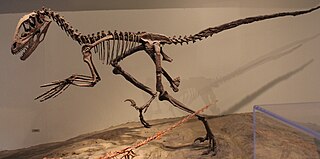
Deinonychus is a genus of dromaeosaurid theropod dinosaur with one described species, Deinonychus antirrhopus. This species, which could grow up to 3.4 meters (11 ft) long, lived during the early Cretaceous Period, about 115–108 million years ago. Fossils have been recovered from the U.S. states of Montana, Utah, Wyoming, and Oklahoma, in rocks of the Cloverly Formation, Cedar Mountain Formation and Antlers Formation, though teeth that may belong to Deinonychus have been found much farther east in Maryland.
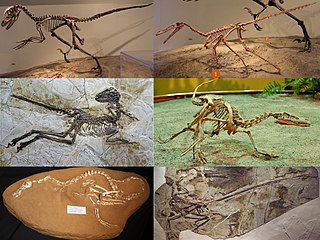
Dromaeosauridae is a family of feathered theropod dinosaurs. They were generally small to medium-sized feathered carnivores that flourished in the Cretaceous Period. The name Dromaeosauridae means 'running lizards', from Greek δρομεῦς meaning 'runner' and σαῦρος meaning 'lizard'. In informal usage they are often called raptors, a term popularized by the film Jurassic Park; a few types include the term "raptor" directly in their name and have come to emphasize their bird-like appearance and speculated bird-like behavior.

Dromaeosaurus is a genus of theropod dinosaur which lived during the Late Cretaceous period, sometime between 80 and 72.8 million years ago, in Alberta, Canada and the western United States. The type species is Dromaeosaurus albertensis, which was described by William Diller Matthew and Barnum Brown in 1922.

Protoceratops is a genus of sheep-sized herbivorous ceratopsian dinosaur, from the Upper Cretaceous Period of what is now Mongolia. It was a member of the Protoceratopsidae, a group of early horned dinosaurs. Unlike later ceratopsians, however, it was a much smaller creature that lacked well-developed horns and retained some basal traits not seen in later genera.

Dinosaur classification began in 1842 when Sir Richard Owen placed Iguanodon, Megalosaurus, and Hylaeosaurus in "a distinct tribe or suborder of Saurian Reptiles, for which I would propose the name of Dinosauria." In 1887 and 1888 Harry Seeley divided dinosaurs into the two orders Saurischia and Ornithischia, based on their hip structure. These divisions have proved remarkably enduring, even through several seismic changes in the taxonomy of dinosaurs.
Dale Alan Russell was an American-Canadian geologist and palaeontologist. Throughout his career Russell worked as the Curator of Fossil Vertebrates at the Canadian Museum of Nature, Research Professor at the Department of Marine Earth and Atmospheric Sciences (MEAS) at North Carolina State University, and Senior Paleontologist at the North Carolina Museum of Natural Sciences. Dinosaurs he has described include Daspletosaurus and Dromiceiomimus, and he was amongst the first paleontologists to consider an extraterrestrial cause for the Cretaceous–Paleogene extinction event. Russell also helped lead the China-Canada Dinosaur Project from 1986 to 1991.
The Magic School Bus In the Time of the Dinosaurs is the sixth book in Joanna Cole and Bruce Degan's The Magic School Bus series.
Maelestes is a prehistoric shrew-like mammal discovered in 1997 in the Gobi Desert. The animal lived in the late Cretaceous Period, around 71-75 million years ago, and was a contemporary of dinosaurs such as Velociraptor and Oviraptor. According to some scientists, the discovery and analysis of this species suggests that true placental mammals appeared near the time the non-avian dinosaurs became extinct 66 million years ago, not much earlier in the Cretaceous as thought by others. However, the presence of an epipubic bone, among other characteristics, place it as a non-placental eutherian.
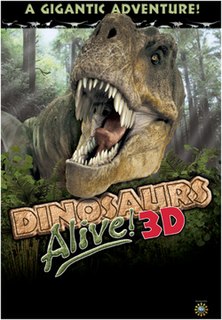
Dinosaurs Alive! is a 2007 IMAX documentary produced by Giant Screen Films about various dinosaurs that inhabited the Earth between 251 and 65 Ma. The documentary features animals from the Triassic period of New Mexico to the Cretaceous period of Mongolia, as well as the American Museum of Natural History's research on both periods.
The Marshall Illustrated Encyclopedia of Dinosaurs and Prehistoric Animals is an encyclopedia of prehistoric and extinct animals which had vertebrae. The Encyclopedia is published by Chartwell Books.
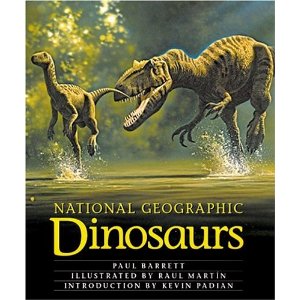
National Geographic Dinosaurs is a nonfiction reference book on dinosaurs, written by Paul Barrett, with illustrations by Raúl Martín, and an introduction by Kevin Padian. It was published in 2001 by National Geographic.
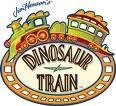
Dinosaur Train is an American-Canadian-Singaporean children's computer-animated television series created by Craig Bartlett, who also created Hey Arnold! and Ready Jet Go!. The series features a curious young Tyrannosaurus rex named Buddy who, together with his adopted Pteranodon family, takes the Dinosaur Train to explore his time period, and have adventures with all kinds of dinosaurs. It is produced by The Jim Henson Company in association with the Info-communications Media Development Authority, Sparky Animation, FableVision, and Snee-Oosh, Inc. and Reel FX and Sea to Sky Entertainment. As of September 2018, PBS Kids had ordered 11 more episodes, taking the total number of episodes to 100. A film based on the series was announced in 2020.
The Dinosaurs!, American television miniseries produced by WHYY-TV for PBS in 1992, featuring some of the then-modern theories about dinosaurs and how they lived. It aired four episodes from November 22 to November 25, 1992.

The Jurassic Museum of Asturias is located in the area of Rasa de San Telmo near the parish of Llastres in the municipality of Colunga, Asturias, Spain. Though the municipality of Ribadesella was initially proposed, Colunga was chosen for the building site in the late 1990s. Several landmarks are visible from the museum including the Bay of Biscay, the Sierra del Sueve, and the Picos de Europa. Strategically located over a mount on the Rasa de San Temo, the museum is in the midst the Jurassic Asturias.
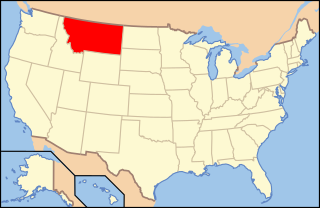
Paleontology in Montana refers to paleontological research occurring within or conducted by people from the U.S. state of Montana. The fossil record in Montana stretches all the way back to the Precambrian. During the Late Precambrian, western Montana was covered by a warm, shallow sea where local bacteria formed stromatolites and bottom-dwelling marine life left tracks on the sediment that would later fossilize. This sea remained in place during the early Paleozoic, although withdrew during the Silurian and Early Devonian, leaving a gap in the local rock record until its return. This sea was home to creatures including brachiopods, conodonts, crinoids, fish, and trilobites. During the Carboniferous the state was home to an unusual cartilaginous fish fauna. Later in the Paleozoic the sea began to withdraw, but with a brief return during the Permian.

Oohkotokia is a genus of ankylosaurid dinosaur within the subfamily Ankylosaurinae. It is known from the upper levels of the Two Medicine Formation of Montana, United States. The discovery of Oohkotokia supports that Ankylosaurine dinosaurs existed and flourished continuously in Montana and/or Alberta throughout the late Campanian and early Maastrichtian stages in the Late Cretaceous period. It was a large, heavily built, quadrupedal, herbivore, that could grow up to 6 m (19.7 ft) long.